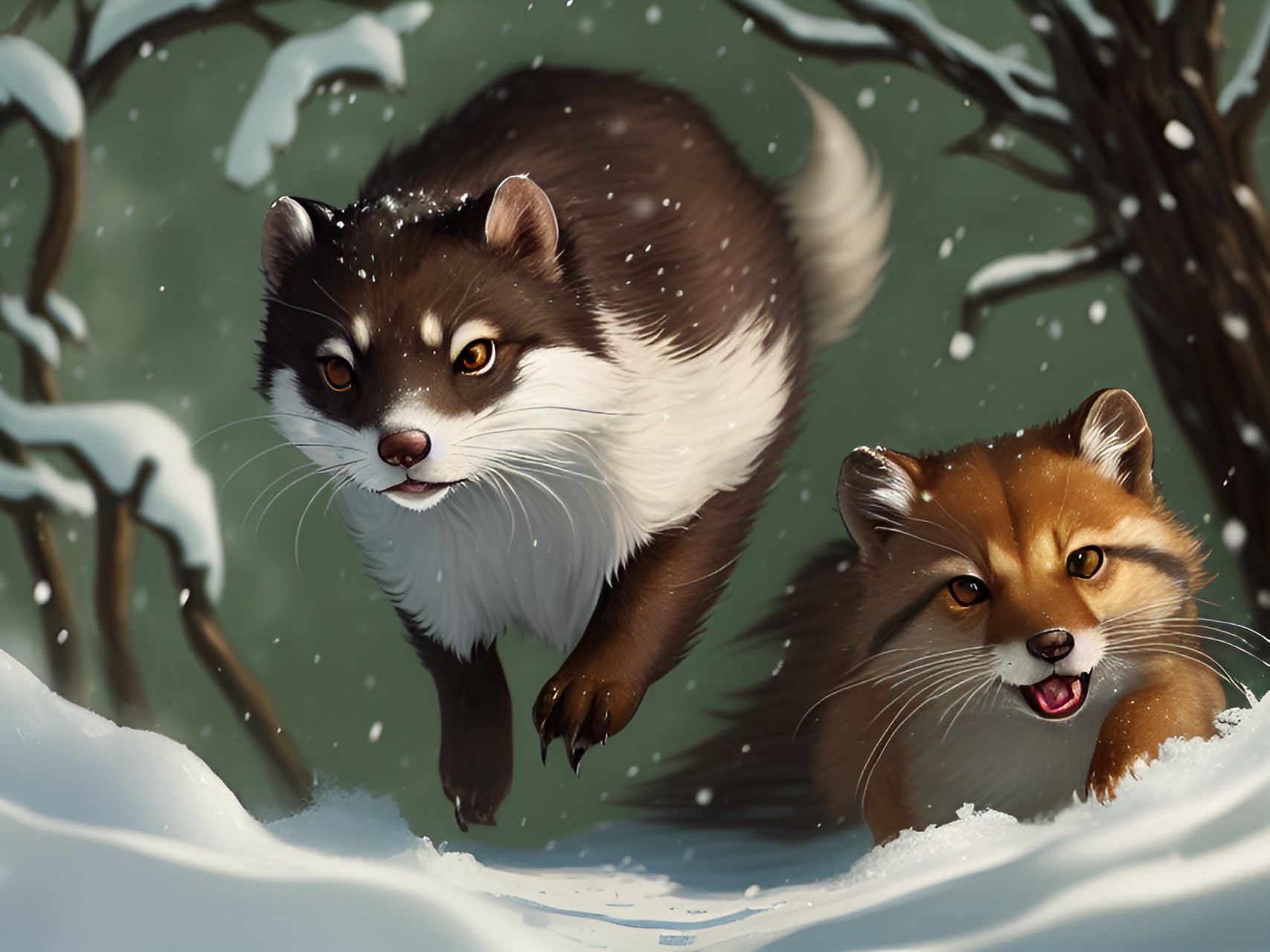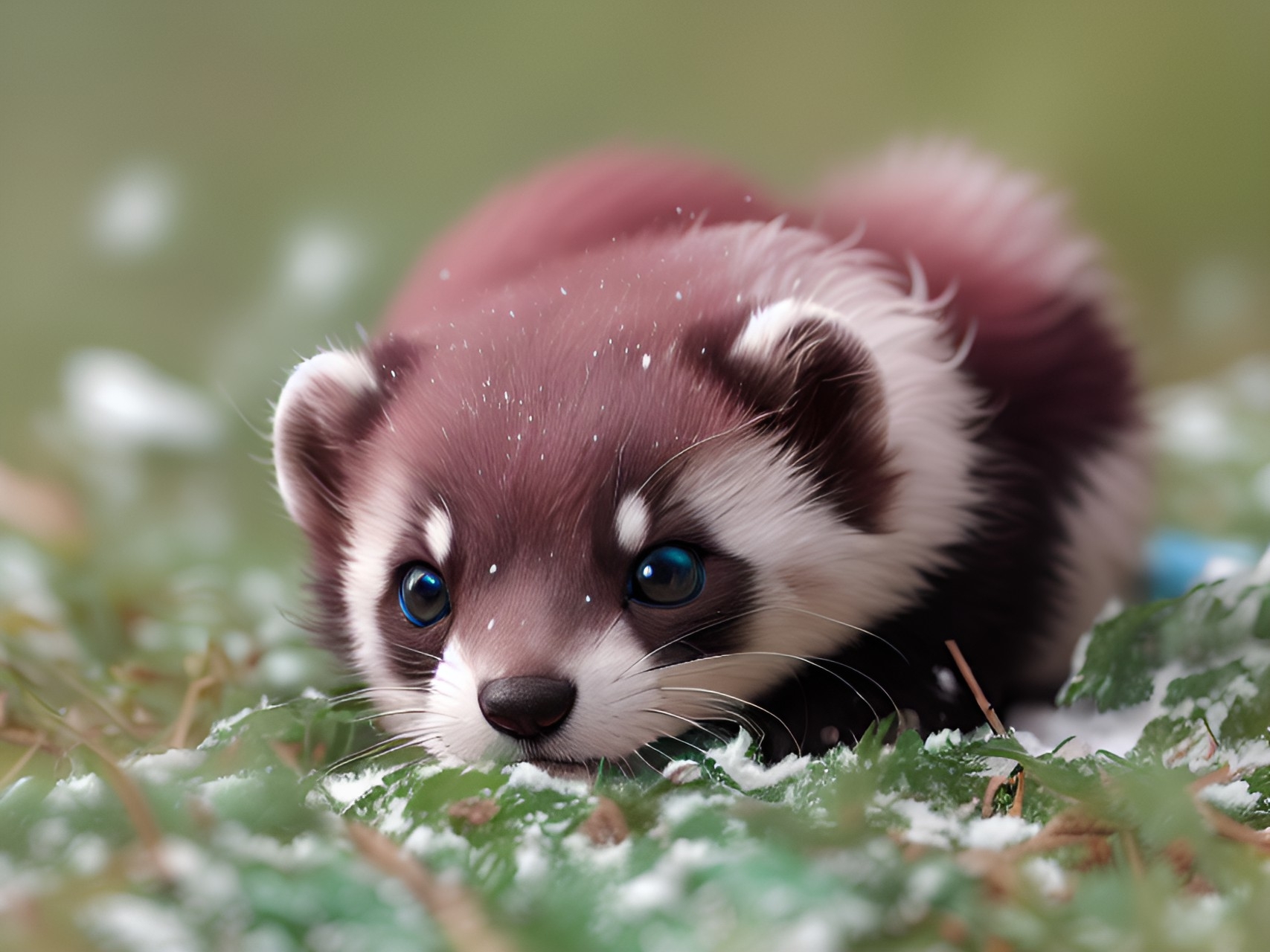Omkhii Polecat
The omkhii polecat is a weasel-like carnivorous mammal found throughout Mongol Uls and the Frozen Wastes. It is a small but energetic mustelid making its home amid seemingly desolate tundra, coated in layers of snow and ice for most of the year. But underneath these layers of frost is a vibrant grassland whose plants and animals thrive thanks to icy kaithur. And despite the polecat's cute face and small size, it is a voracious and efficient predator!
Local Khalkh Monggols call these mustelids tsaivar khokh omkhii. This means pale blue stench for the powerful smelling fluid they are capable of spraying and their blue fur. Omkhii are especially mischievous and troublesome critters as their kaihur renders them impossible to impede, frequently sneaking into food supplies without notice! Fliris's Slip allows omkhii to pass right through any barrier and their Sense manifestation makes them perceptive to movements, easily slipping in when there is no sign of life inside.
|
Fliris' Slip
Thanks to Fliris' Slip, Omkhii cannot be impeded by anything, slipping right through physical barriers. They can move with increasing, cumulative speed and velocity but have poor control the faster they go. They cannot interact with anything while slipping and cannot maintain this state unless they continually move, however much. | [t/r]
Anatomy |
Omkhii are similar to other mustelids like the weasel and ferret, having rounded ears, a long body and tail and short legs. While they are larger than weasels they are still smaller than otters, females being smaller than males. They are slightly longer than the Eluzian polecat, having a more powerfully built skull for biting. In fact, amid other polecats they have particularly strong claws and large teeth, its usual method for finishing off prey! But the easiest way to identify an omkhii polecat is by smell, known for its foul odor! Each omkhii has well developped anal glands which produce an oily, yellow musk--a pungent and sharp liquid which can be sprayed in self-defense.
|
Senses |
Omkhii are exceptionally agile, greatly dependant on their sense of hearing and smell because their eyesight is so poor (especially their depth perception). They can leap up to one meter at a time and appear to follow a random walk trajectory while searching for prey. Equally reliant on their kaithur, which alots them a unique advantage in hunting, omkhii are able to sense movements all around them and through barriers! This pulls information from within Fliris' Plane and is automatically fed directly into their mind as a sixth sense. Anything and everything in motion is within their perception--a potent tool while hunting prey burrowed deep within the tundra snow or aerial predators above. |
Habitat |
Most omkhii polecats wander the wide open steppes and tundra of Mongol Uls but they also might be found in the Frozen Wastes, the Ural'skaya Belt and Zhongguo. They will settle into meadows, pastures, uncultivated fields and even ravines or abandoned quarries--anywhere their small mammalian prey reside. And to the frustration of local Khalkh Monggol, they have a skill for wriggling their way into places they shouldn't be or popping out of the ground to frighten people. You never know where they'll manage to squeeze into when looking for somewhere warm to hunker down! It is their skill in curbing pest species that causes humans to overlook their mischievous and smelly presence. |
Diet |
These mustelids are fully carnivorous, hunting at night and occasionally twilight. They prey on ground squirrels, mice, rats, hamsters, pikas, moles, voles, qafz jerboa and marmots, ground squirrels making up the bulk of their diet throughout the year. When near rivers and lakes they will also hunt water voles, fish, chickens and carrion though they may occasionally kill birds such as partridges and grouse too.
As for their methods, omkhii rely heavily on their kaithur to locate and reach their prey. Their ancestors were already highly successful hunters, further sharpend by magic. Hunting amid deep snowdrifts and tundra ice, which shelters a surprisingly versatile grassland, many of their prey have adaptions and kaithur which allows them to live beneath these barriers or even inside the ice! Equipped with Fliris movement magic, omkhii are able to both sense movements all around them and can move through any barrier. This means they can sense the movements of their prey beneath the snow and ice and, once identified, slip right through thick ice, snow or even earth to make their kill. Their ability to sense movements also comes in handy as a defensive measure, picking up the movements of aerial predators above. Yet even if they must run down prey or flee larger predators on foot, they can move with increasing and accumulated velocity, going faster the longer they run but lacking fine control the faster the go. |
Life Cycle |
Females polecats are called jill, males are called hob and babies are kits. Polygamous by nature, hob will mate with more than one jill. Hobs only become territorial during this mating season, making shows of dominance through aggressive behavior and vocalizations. Omkhii don't dig their own burrows, taking over the dens of their prey and only needing to widen them. While omkhii prefer to live on their own, they usually only interact with each other and live in family burrows during the breeding season, ranging from March to April. Before mating, hobs drag an unresisting jill around the den by her scruff, oddly enough signaling her body to release eggs! After a pregnancy of 36-43 days, jill can give birth to 3-6 kits though litters of 18 are also possible.
Nursing jill are far more settled down but will begin roaming again once their kits are old enough travel. Kits are born blind and naked with pale rosy skin, their eyes not opening until they are 28-34 days old. They become more acive at this point, often practicing by ripping apart the carcases supplied by their parents, even while still relying on their mothers milk. By the age of 45 days kits are capable of hunting young ground squirrels and can target adults at the age of two months! These kits remain in the family burrow for another two or so months before dispersing in July or later. At 10 months they are reproductively active but don't reach full adulthood until two years. |
Behavior |
These are mischievous little creatures, often sneaking into people's homes and munching on stored food. Sometimes they'll even tinker with children's toys and pilfer shiny objects. If one digs around the steppe, they might find little treasures stashed away in burrows alongside half eaten prey! They are extremely energetic with a measure of restlessness and curiosity. These furry little noodles commonly zip across the steppe at ridiculous speeds, unimpeded and chaotic--a sign that they are happy!
They are playful, especially with each other, but this play can easily get too rough. Despite being agile they are also extremely clumsy due to poor eyesight, their extreme speed and difficulty stopping only worsening this. Every now and then they can be seen crashing into a snowdrift, white powder bursting everywhere! If they are feeling particularly energetic and bold, omkhii enjoy chasing after children and cattle of the Khalkh Monggol tribes. Most know this to be harmless and there is even a popular children's game, drawing them out with food or shiny trinkets before essentially playing tag with them! |

















Comments